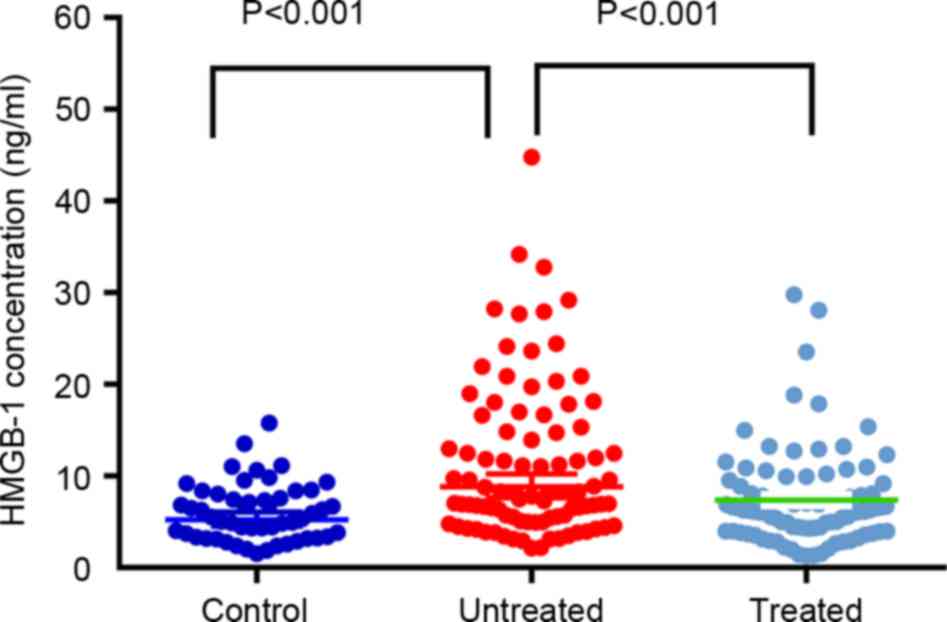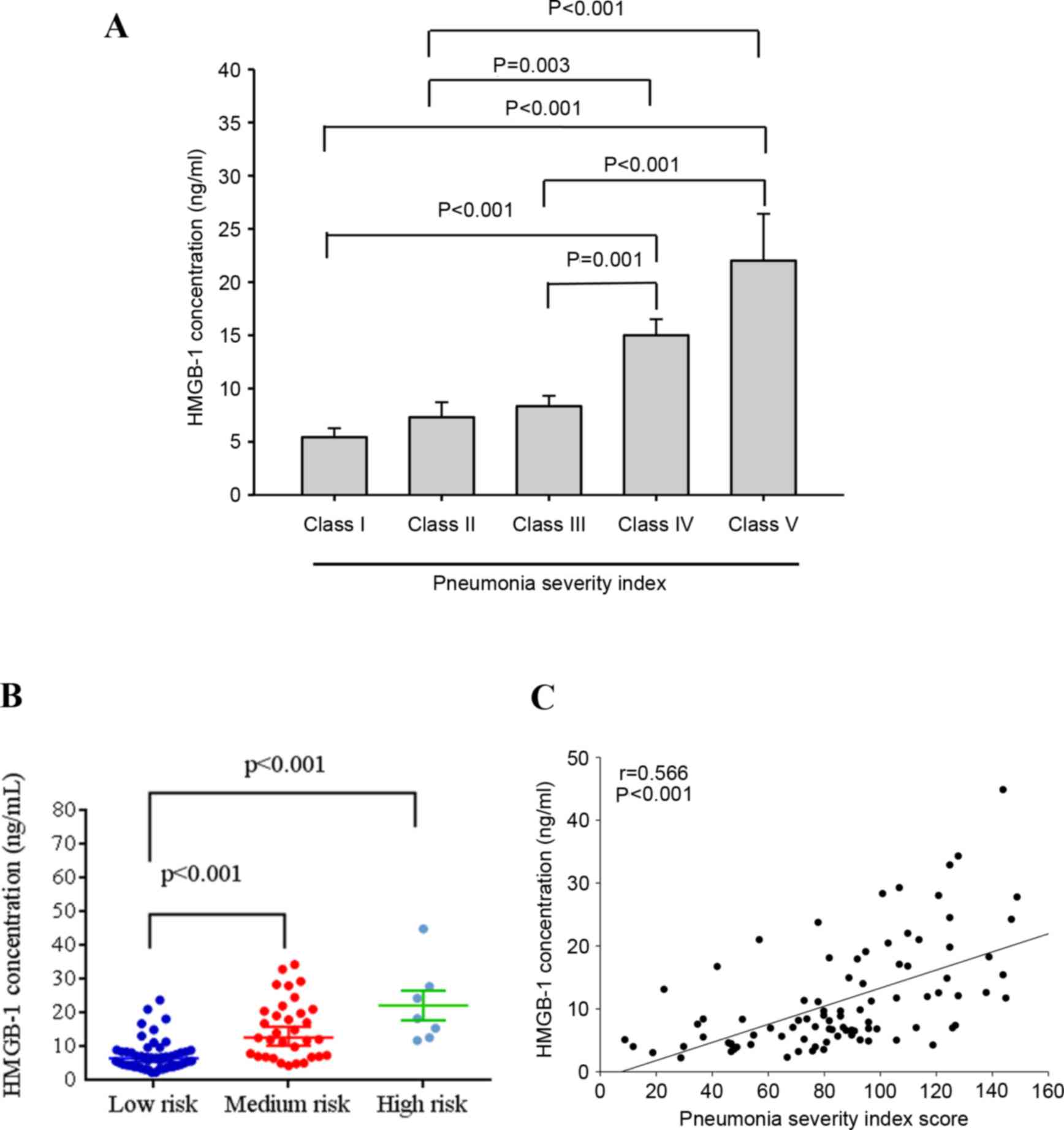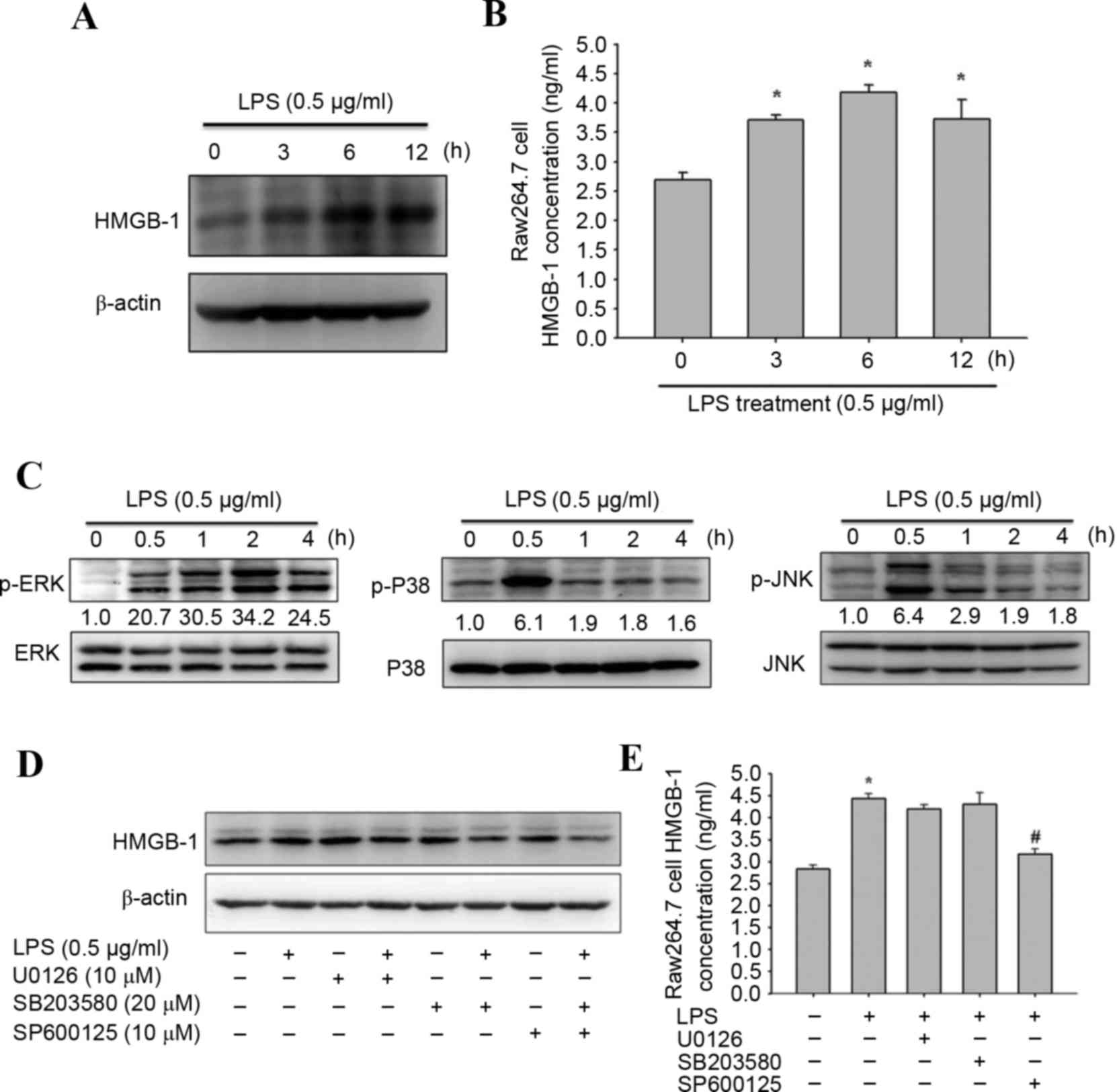|
1
|
Czura CJ, Wang H and Tracey KJ: Dual roles
for HMGB1: DNA binding and cytokine. J Endotoxin Res. 7:315–321.
2001. View Article : Google Scholar : PubMed/NCBI
|
|
2
|
Andersson U and Tracey KJ: HMGB1 in
sepsis. Scand J Infect Dis. 35:577–584. 2003. View Article : Google Scholar : PubMed/NCBI
|
|
3
|
Magna M and Pisetsky DS: The role of HMGB1
in the pathogenesis of inflammatory and autoimmune diseases. Mol
Med. 20:138–146. 2014. View Article : Google Scholar : PubMed/NCBI
|
|
4
|
Cai J, Wen J, Bauer E, Zhong H, Yuan H and
Chen AF: The role HMGB1 in cardiovascular biology: Danger signals.
Antioxid Redox Signal. 23:1351–1369. 2015. View Article : Google Scholar : PubMed/NCBI
|
|
5
|
Weber DJ, Allette YM, Wilkes DS and White
FA: The HMGB1-RAGE inflammatory pathway: Implications for brain
injury-induced pulmonary dysfunction. Antioxid Redox Signal.
23:1316–1328. 2015. View Article : Google Scholar : PubMed/NCBI
|
|
6
|
Kang R, Zhang Q, Zeh HJ III, Lotze MT and
Tang D: HMGB1 in cancer: Good, bad, or both? Clin Cancer Res.
19:4046–4057. 2013. View Article : Google Scholar : PubMed/NCBI
|
|
7
|
Tang D, Kang R, Zeh HJ III and Lotze MT:
High-mobility group box 1 and cancer. Biochim Biophys Acta.
1799:131–140. 2010. View Article : Google Scholar : PubMed/NCBI
|
|
8
|
Hsieh MJ, Hsieh YH, Lin CW, Chen MK, Yang
SF and Chiou HL: Transcriptional regulation of Mcl-1 plays an
important role of cellular protective effector of
vincristine-triggered autophagy in oral cancer cells. Expert Opin
Ther Targets. 19:455–470. 2015. View Article : Google Scholar : PubMed/NCBI
|
|
9
|
Andersson U, Erlandsson-Harris H, Yang H
and Tracey KJ: HMGB1 as a DNA-binding cytokine. J Leukoc Biol.
72:1084–1091. 2002.PubMed/NCBI
|
|
10
|
Wang H, Bloom O, Zhang M, Vishnubhakat JM,
Ombrellino M, Che J, Frazier A, Yang H, Ivanova S, Borovikova L, et
al: HMG-1 as a late mediator of endotoxin lethality in mice.
Science. 285:248–251. 1999. View Article : Google Scholar : PubMed/NCBI
|
|
11
|
Schierbeck H, Pullerits R, Pruunsild C,
Fischer M, Holzinger D, Laestadius Å, Sundberg E and Harris HE:
HMGB1 levels are increased in patients with juvenile idiopathic
arthritis, correlate with early onset of disease, and are
independent of disease duration. J Rheumatol. 40:1604–1613. 2013.
View Article : Google Scholar : PubMed/NCBI
|
|
12
|
Wang H, Ward MF and Sama AE: Targeting
HMGB1 in the treatment of sepsis. Expert Opin Ther Targets.
18:257–268. 2014. View Article : Google Scholar : PubMed/NCBI
|
|
13
|
Lindström O, Tukiainen E, Kylänpää L,
Mentula P, Rouhiainen A, Puolakkainen P, Rauvala H and Repo H:
Circulating levels of a soluble form of receptor for advanced
glycation end products and high-mobility group box chromosomal
protein 1 in patients with acute pancreatitis. Pancreas.
38:e215–e220. 2009. View Article : Google Scholar : PubMed/NCBI
|
|
14
|
Tang D, Kang R, Cao L, Zhang G, Yu Y, Xiao
W, Wang H and Xiao X: A pilot study to detect high mobility group
box 1 and heat shock protein 72 in cerebrospinal fluid of pediatric
patients with meningitis. Crit Care Med. 36:291–295. 2008.
View Article : Google Scholar : PubMed/NCBI
|
|
15
|
Nin JW, Ferreira I, Schalkwijk CG, Jorsal
A, Prins MH, Parving HH, Tarnow L, Rossing P and Stehouwer CD:
Higher plasma high-mobility group box 1 levels are associated with
incident cardiovascular disease and all-cause mortality in type 1
diabetes: A 12 year follow-up study. Diabetologia. 55:2489–2493.
2012. View Article : Google Scholar : PubMed/NCBI
|
|
16
|
Tseng CC, Fang WF, Leung SY, Chen HC,
Chang YC, Wang CC, Chang HC and Lin MC: Impact of serum biomarkers
and clinical factors on intensive care unit mortality and 6-month
outcome in relatively healthy patients with severe pneumonia and
acute respiratory distress syndrome. Dis Markers. 2014:8046542014.
View Article : Google Scholar : PubMed/NCBI
|
|
17
|
Ito Y, Torii Y, Ohta R, Imai M, Hara S,
Kawano Y, Matsubayashi T, Inui A, Yoshikawa T, Nishimura N, et al:
Increased levels of cytokines and high-mobility group box 1 are
associated with the development of severe pneumonia, but not acute
encephalopathy, in 2009 H1N1 influenza-infected children. Cytokine.
56:180–187. 2011. View Article : Google Scholar : PubMed/NCBI
|
|
18
|
Higa F, Furugen M, Koide M, Karimata Y,
Nabeya D, Iha Y, Kinjo T, Miyagi K, Haranaga S, Hokama A, et al:
Clinical evaluation of high mobility group box 1 protein in
Legionella pneumophila pneumonia. J Infect Chemother. 20:289–292.
2014. View Article : Google Scholar : PubMed/NCBI
|
|
19
|
Achouiti A, van der Meer AJ, Florquin S,
Yang H, Tracey KJ, van't Veer C, de Vos AF and van der Poll T:
High-mobility group box 1 and the receptor for advanced glycation
end products contribute to lung injury during Staphylococcus aureus
pneumonia. Crit Care. 17:R2962013. View
Article : Google Scholar : PubMed/NCBI
|
|
20
|
Angus DC, Yang L, Kong L, Kellum JA,
Delude RL, Tracey KJ, Weissfeld L, et al: GenIMS Investigators:
Circulating high-mobility group box 1 (HMGB1) concentrations are
elevated in both uncomplicated pneumonia and pneumonia with severe
sepsis. Crit Care Med. 35:1061–1067. 2007. View Article : Google Scholar : PubMed/NCBI
|
|
21
|
Chiang TY, Tsao SM, Yeh CB and Yang SF:
Matrix metalloproteinases in pneumonia. Clin Chim Acta.
433:272–277. 2014. View Article : Google Scholar : PubMed/NCBI
|
|
22
|
Cheng CW, Chien MH, Su SC and Yang SF: New
markers in pneumonia. Clin Chim Acta. 419:19–25. 2013. View Article : Google Scholar : PubMed/NCBI
|
|
23
|
Berg P and Lindhardt BØ: The role of
procalcitonin in adult patients with community-acquired pneumonia-a
systematic review. Dan Med J. 59:A43572012.PubMed/NCBI
|
|
24
|
Lippi G, Meschi T and Cervellin G:
Inflammatory biomarkers for the diagnosis, monitoring and follow-up
of community-acquired pneumonia: Clinical evidence and
perspectives. Eur J Intern Med. 22:460–465. 2011. View Article : Google Scholar : PubMed/NCBI
|
|
25
|
Fine MJ, Auble TE, Yealy DM, Hanusa BH,
Weissfeld LA, Singer DE, Coley CM, Marrie TJ and Kapoor WN: A
prediction rule to identify low-risk patients with
community-acquired pneumonia. N Engl J Med. 336:243–250. 1997.
View Article : Google Scholar : PubMed/NCBI
|
|
26
|
Yang SF, Lee WJ, Tan P, Tang CH, Hsiao M,
Hsieh FK and Chien MH: Upregulation of miR-328 and inhibition of
CREB-DNA-binding activity are critical for resveratrol-mediated
suppression of matrix metalloproteinase-2 and subsequent metastatic
ability in human osteosarcomas. Oncotarget. 6:2736–2753. 2015.
View Article : Google Scholar : PubMed/NCBI
|
|
27
|
Warszawska JM, Gawish R, Sharif O, Sigel
S, Doninger B, Lakovits K, Mesteri I, Nairz M, Boon L, Spiel A, et
al: Lipocalin 2 deactivates macrophages and worsens pneumococcal
pneumonia outcomes. J Clin Invest. 123:3363–3372. 2013. View Article : Google Scholar : PubMed/NCBI
|
|
28
|
Wu Q, Li H, Qiu J and Feng H: Betulin
protects mice from bacterial pneumonia and acute lung injury.
Microb Pathog. 75:21–28. 2014. View Article : Google Scholar : PubMed/NCBI
|
|
29
|
Bode JG, Ehlting C and Häussinger D: The
macrophage response towards LPS and its control through the
p38(MAPK)-STAT3 axis. Cell Signal. 24:1185–1194. 2012. View Article : Google Scholar : PubMed/NCBI
|
|
30
|
Su SC, Hua KF, Lee H, Chao LK, Tan SK, Lee
H, Yang SF and Hsu HY: LTA and LPS mediated activation of protein
kinases in the regulation of inflammatory cytokines expression in
macrophages. Clin Chim Acta. 374:106–115. 2006. View Article : Google Scholar : PubMed/NCBI
|
|
31
|
Andersson U, Wang H, Palmblad K, Aveberger
AC, Bloom O, Erlandsson-Harris H, Janson A, Kokkola R, Zhang M,
Yang H and Tracey KJ: High mobility group 1 protein (HMG-1)
stimulates proinflammatory cytokine synthesis in human monocytes. J
Exp Med. 192:565–570. 2000. View Article : Google Scholar : PubMed/NCBI
|
|
32
|
Treutiger CJ, Mullins GE, Johansson AS,
Rouhiainen A, Rauvala HM, Erlandsson-Harris H, Andersson U, Yang H,
Tracey KJ, Andersson J and Palmblad JE: High mobility group 1 B-box
mediates activation of human endothelium. J Intern Med.
254:375–385. 2003. View Article : Google Scholar : PubMed/NCBI
|
|
33
|
Abisheganaden J, Ding YY, Chong WF, Heng
BH and Lim TK: Predicting mortality among older adults hospitalized
for community-acquired pneumonia: An enhanced confusion, urea,
respiratory rate and blood pressure score compared with pneumonia
severity index. Respirology. 17:969–975. 2012. View Article : Google Scholar : PubMed/NCBI
|
|
34
|
Lee YT, Chen SC, Shyu LY, Lee MC, Wu TC,
Tsao SM and Yang SF: Significant elevation of plasma cathepsin B
and cystatin C in patients with community-acquired pneumonia. Clin
Chim Acta. 413:630–635. 2012. View Article : Google Scholar : PubMed/NCBI
|
|
35
|
Wang HL, Hsiao PC, Tsai HT, Yeh CB and
Yang SF: Usefulness of plasma YKL-40 in management of
community-acquired pneumonia severity in patients. Int J Mol Sci.
14:22817–22825. 2013. View Article : Google Scholar : PubMed/NCBI
|
|
36
|
Haugen J, Chandyo RK, Brokstad KA,
Mathisen M, Ulak M, Basnet S, Valentiner-Branth P and Strand TA:
Cytokine concentrations in plasma from children with severe and
non-severe community acquired pneumonia. PLoS One. 10:e01389782015.
View Article : Google Scholar : PubMed/NCBI
|
|
37
|
Yang H, Wang H, Czura CJ and Tracey KJ:
The cytokine activity of HMGB1. J Leukoc Biol. 78:1–8. 2005.
View Article : Google Scholar : PubMed/NCBI
|
|
38
|
Hagiwara S, Iwasaka H, Matsumoto S and
Noguchi T: Changes in cell culture temperature alter release of
inflammatory mediators in murine macrophagic RAW264.7 cells.
Inflamm Res. 56:297–303. 2007. View Article : Google Scholar : PubMed/NCBI
|
|
39
|
Hasegawa A, Iwasaka H, Hagiwara S and
Noguchi T: Relationship between HMGB1 and tissue protective effects
of HSP72 in a LPS-induced systemic inflammation model. J Surg Res.
169:85–91. 2011. View Article : Google Scholar : PubMed/NCBI
|
|
40
|
Tsoyi K, Lee TY, Lee YS, Kim HJ, Seo HG,
Lee JH and Chang KC: Heme-oxygenase-1 induction and carbon
monoxide-releasing molecule inhibit lipopolysaccharide
(LPS)-induced high-mobility group box 1 release in vitro and
improve survival of mice in LPS- and cecal ligation and
puncture-induced sepsis model in vivo. Mol Pharmacol. 76:173–182.
2009. View Article : Google Scholar : PubMed/NCBI
|
|
41
|
Ding N, Wang F, Xiao H, Xu L and She S:
Mechanical ventilation enhances HMGB1 expression in an LPS-induced
lung injury model. PLoS One. 8:e746332013. View Article : Google Scholar : PubMed/NCBI
|
|
42
|
Hagiwara S, Iwasaka H, Matsumoto S,
Hasegawa A, Yasuda N and Noguchi T: In vivo and in vitro effects of
the anticoagulant, thrombomodulin, on the inflammatory response in
rodent models. Shock. 33:282–288. 2010. View Article : Google Scholar : PubMed/NCBI
|

















